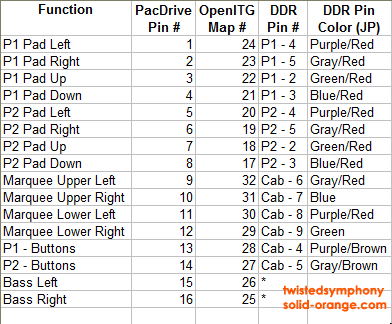Here's how you get the software working for PacDrive support in Open In the Groove.
First you need Lib-USB Win32 drivers installed. I used the Zadig package here:
http://zadig.akeo.ie/
There is a Windows XP specific build, make sure you download that one if you're using Win XP.
To Install Lib-USB Drivers you'll want do the following:
1. click Device->Create New Device
2. click Options->List All Devices
3. Select the PacDrive from the drop down list. *See note below
4. Select "libusb-win32" from the drive selection list
5. click the big button below the drive selection list to install it.
*Note: Make Sure the PacDrive is plugged into your computer. On Win 7 it came up as "LED Controller" but on XP it was listed as "Human Interface Device" which is totally useless. However the USB ID should be D209 1500, which is a good way to tell it apart from other devices that might have the same name. I believe they make variants of the PacDrive with different USB IDs (so that you can run multiple PacDrives on the same hardware) but you do have to special order these so it's likely that you dont' have one.
Once the Drivers are installed you'll want to edit the static.ini file, this is located in the Data folder wherever you have OpenITG installed (the default location is inside program files).
From here you want to find the [options] section and in that section set LightsDriver=PacDrive as well as LogToDisk=1
if those settings aren't listed then add them.
Then you should run oITG... if all goes well then the pac drive should be working. If Not check the log file that will have been created in the root OpenITG folder in here it will show you any error messages related to the PacDrive.
I found that if it was having problems initializing the PacDrive then it's usually a problem with the Lib-USB driver, though there are other things that can cause problems too.
The first time you run OpenITG with lights enabled and if it successfully initialized the PacDrive it will create a LightsMaps.ini file in Data folder. here you'll be able to re-assign different light signals to different outputs on the PacDrive. The numbers they use for light mapping aren't at all obvious though.
The default Mapping is as follows:
If you want to use the correct connectors to plug into the light connectors on a DDR cab you can order them directly from JSTs website:
https://order.jst-mfg.com
XMR-10V: The 10 pin connector used for Player 1, Player 2 and Cab lights (so you'll need 3 of these)
XMR-06V: The 6 pin connector used for the Bass Neon Lights
SXM-01-P0.6: The pins for the above connectors, you'll need 21 of these to cover all the pins


 so I've got to find a replacement for that before I can find a solution to switch it.
so I've got to find a replacement for that before I can find a solution to switch it.




 And since he had the Player2 Start button set to the comma key in WinIPAC, there was an issue where that key wasn't being saved to the .ini file, as the key def lines in the file are comma delimited and adding the 3rd comma was a problem. He switched it to another key and it was fine.
And since he had the Player2 Start button set to the comma key in WinIPAC, there was an issue where that key wasn't being saved to the .ini file, as the key def lines in the file are comma delimited and adding the 3rd comma was a problem. He switched it to another key and it was fine.


